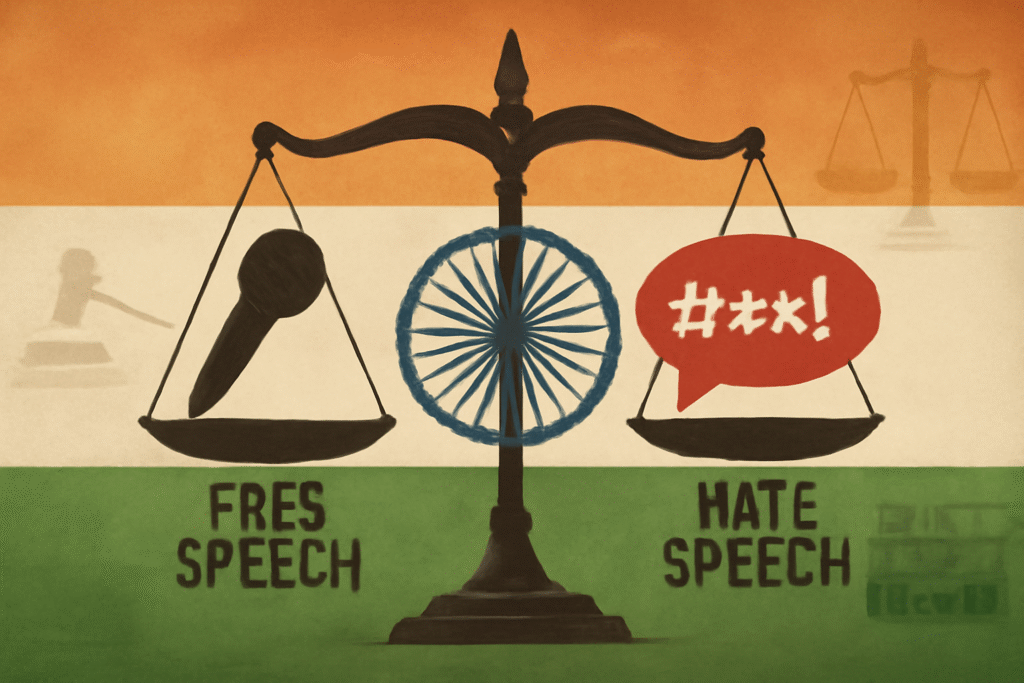Published on 8th April 2025
Authored By: Syed Tauheed
Vidyavardhaka Law College
Abstract
India confronts major water contamination issues which stem from industrial operations and agricultural practices as well as urban region requirements. India has developed a solid system of laws and regulations through the Water (Prevention and Control of Pollution) Act, 1974, the Environment Protection Act, 1986, and the National Green Tribunal Act, 2010 to fight water pollution issues. The established laws grant authorities the right to control industrial disposal of wastewater and to maintain water body purity from pollution sources. Water Cess Act, 1977 along with Public Liability Insurance Act, 1991 enable legal enforcement for financial liability of water pollution by industrial sectors. The legal provisions currently protecting the environment fail to enforce necessary regulations because monitoring is insufficient and compliance is weak and industries exercise pressure.
Introduction
India faces a large environmental dilemma from water pollution that negatively impacts both its public health as well as biodiversity and water supply for local communities. Industrial expansion together with urban development and agricultural activities has resulted in widespread water contamination of lakes and groundwater and rivers which endangers ecosystems and human welfare status. The Indian government created multiple comprehensive laws as a solution to combat and stop water pollution. Water (Prevention and Control of Pollution) Act 1974 and Environment Protection Act 1986 alongside National Green Tribunal Act 2010 provide the country with mechanisms to monitor and regulate and manage water quality throughout all areas. Pollution control frameworks in India have made noteworthy progress through government legislation yet implementation difficulties and insufficient infrastructure and industrial non-compliance significantly reduce their performance success. [1]
The Water (Prevention and Control of Pollution) Act 1974
The Water (Prevention and Control of Pollution) Act, 1974 serves as a foundational piece of Indian law which seeks to resolve escalating water pollution challenges in the nation. This legislation protects water bodies in the country through two main bodies: Central Pollution Control Board (CPCB) and State Pollution Control Boards (SPCBs). They have authority to take precautionary actions for water pollution prevention. The main purpose of this legislation protects India’s water supply from polluting agents while maintaining water body sustainability for public health together with agricultural usage and industrial activities and ecosystem requirements.
With this legal instrument the CPCB and SPCBs obtain authority to create and implement water quality benchmarking systems for different water reservoirs from rivers to lakes and groundwater. Water sources receive specific protection through the law which demands consent from pollution control boards before local bodies and industries disperse wastewater or effluents into water bodies. The permission can be obtained from the boards only if wastewater discharges satisfy the defined quality standards for pollution prevention.[2]
The Water Act grants authorities the power to execute punishment against rule violators as a chief regulatory provision. Under the terms of this law authorities can levy monetary sanctions on businesses in addition to individuals who break water quality rules or release untreated waste into water reservoirs. The law authorizes authorities to disable polluting industries permanently or temporarily pause their industrial operations in extreme cases. The Act also grants the government the authority to build wastewater treatment facilities as well as other necessary infrastructure for environmental wastewater discharge. People encounter various obstacles when trying to enforce the Water (Prevention and Control of Pollution) Act despite its recognized vital importance. [3]
The Water (Prevention and Control of Pollution) Act has faced obstacles because of insufficient monitoring and insufficient wastewater treatment systems and limited general public awareness. The Water (Prevention and Control of Pollution) Act represents a vital piece of Indian constitutional law for controlling water pollution although better implementation with enhanced government support for environmental protection is required.
Environment Protection Act 1986
Indian authorities enacted the Environment Protection Act of 1986 as a complete legal framework to handle environmental deterioration together with sustainable growth promotion. The Environment Protection Act 1986 establishes a conceptual framework which directs environmental protection work across India. Through its extensive powers the central government can make all necessary decisions to stop environmental pollution and safeguard the environment by establishing water pollution regulations.
The Water (Prevention and Control of Pollution) Act, 1974 concentrated on water bodies but the Environment Protection Act extends its coverage across air platforms and land resources as well as water bodies. Under the Act the Central Government obtains the authority to establish quality standards for air, water and soil and hazardous substance handling and waste disposal procedures. The Act gives authorities the power to design rules that control industrial discharges of pollution substances through regulations of wastewater disposal and management of hazardous products and chemical reserves. [4]
Under the Environment Protection Act the government exercises authorization to release protective directives which advance pollution prevention and management operations. The environmental protection system works through establishing mandatory environmental audits alongside environmental standards and demanding industries to obtain clearances before starting their operations.
The government can penalize environmental damage offenders using fines and imprisonment according to provisions of the Act. The Act created both the Central Pollution Control Board (CPCB) as well as authorized the federal government to develop local pollution control organizations which would execute environmental protection plans. The adjustments made through the Environment Protection Act helped India by advancing its environmental condition but multiple obstacles persist from poor enforcement practices to insufficient pollution control facilities and active resistance from industries
National Green Tribunal (NGT) Act, 2010
The National Green Tribunal (NGT) Act, 2010 created a specialized body known as the National Green Tribunal (NGT) to handle disputes regarding environmental issues in India at a rapid pace. The NGT operates with the purpose of creating an accessible and effective platform to handle environmental protection matters including water pollution issues. The National Green Tribunal possesses legal power to settle environmental cases regarding violations of multiple statutes like the Water (Prevention and Control of Pollution) Act and Environment Protection Act besides others. By following environmental regulations the Tribunal ensures compliance and it has powers to apply penalties in addition to issuing remediation directions while compensating those impacted by environmental damages. Establishment of the NGT serves as a major step forward towards increased environmental protection responsibility from public and private entities while providing specialized water pollution solutions for India.[5]
River Board Act 1956
India established the River Boards Act of 1956 to manage interstate rivers together with river valleys throughout the country. Through the Act Indian authorities created River Boards to direct development management and protection tasks across multiple state borders. The main purpose of the Act exists to stop river water usage disputes among states and establish cooperative water management with guaranteed water quality standards. According to the provisions of this Act the central government possesses the power to create River Boards for managing interstate rivers and river valleys.
The boards obtain authority to execute numerous activities such as water quality regulation alongside pollution prevention and the building of projects like irrigation systems and dams. Besides overseeing water distribution they perform basin management duties that unite states which share river waters. The River Boards function as government advisors for both best water resource management practices and river pollution prevention in mutual waterways. Through the River Boards Act the government established regulations for managing interstate rivers but its practical use is restricted and states have failed to address crucial water pollution matters because of both political challenges and poor inter-state collaboration. The Act proves helpful but has failed to achieve its desired outcomes of controlling water pollution while settling disputes about water allocation.
Water quality standards
Regional and national standards in India will protect surface waters and groundwater from contaminations while maintaining their safety for people and aquatic life and ecological systems. Resource management standards in India have been established through the collaboration of Central Pollution Control Board (CPCB) and State Pollution Control Boards (SPCBs).
The established standards specify maximum allowed pollution measurements for dissolving oxygen together with pH levels and heavy metals alongside BOD and COD in multiple water environments. The requirements for water quality depend on its designated use between different regions either for human consumption or for irrigation and industrial operations and recreational purposes. The safety requirements for drinking water exceed those used to maintain recreational water bodies. The National Water Quality Monitoring Programme (NWQMP) monitors water quality conditions across the nation to locate polluted areas where corrective steps for improvement can be executed. Active water quality standard enforcement together with regular monitoring play essential roles in safeguarding public health along with protecting environmental health.
National Water Policy (2012)
The National Water Policy (2012) established by Government of India established an advanced system to sustainably manage and use water resources throughout India. As a key element of the policy the Government of India decided integrated water resources management must work alongside agricultural interests and industrial concerns and urban requirements and environmental needs for balance. The policy establishes water as fundamental for achieving socio-economic growth and maintaining public well-being. The policy advances three critical elements through its mandate of water preservation alongside wastewater re-use operations and sewage treatment for pollution reduction efforts. [6]
The policy requires water allocation should be distributed equitably so every person especially disadvantaged groups can obtain access to clean water. Through this policy the government supports water pollution regulation enforcement and endorses efficient water management practices for agricultural operations as well as urban landscapes. Water management initiatives requiring community participation receive focus in the National Water Policy as it advocates for new water conservation technologies and innovations that boost efficiency.
Legal Disposal Methods
- Effluent Treatment Plants (ETPs)
- Sewage Treatment Plants (STPs)
- River or Water Body Discharge (Regulated)
- Reuse and Recycling within the Facility
- n-Site Treatment and Disposal
Case laws
- C. Mehta v. Union of India (1988) – Ganga Pollution Case
The Supreme Court allowed the activist M.C. Mehta to establish this landmark case because of Ganges River water pollution. The Supreme Court of India chose to award protection rights to the living entity that is the Ganges. The Court required all industries bordering the river to build effluent treatment plants (ETPs) which would stop their uncontrolled waste release into the water body. The Court showcased its commitment to execute water pollution regulations while showing the pivotal role of major water bodies in Indian preservation in this pivotal judicial decision[7].
- Vellore Citizens Welfare Forum v. Union of India (1996)
The Supreme Court allowed the activist M.C. Mehta to establish this landmark case because of Ganges River water pollution. The Supreme Court of India chose to award protection rights to the living entity that is the Ganges. The Court required all industries bordering the river to build effluent treatment plants (ETPs) which would stop their uncontrolled waste release into the water body. The Court showcased its commitment to execute water pollution regulations while showing the pivotal role of major water bodies in Indian preservation in this pivotal judicial decision.
Conclusion
In Conclusion In the past several decades, India has established a well-founded legal framework to control pollution of water within the country. Some of the major statutes included within this legal framework include the Water (Prevention and Control of Pollution) Act, 1974, the Environment Protection Act, 1986, as well as the National Green Tribunal (NGT) Act, 2010. These acts deal with the matter of waste discharges and its prevention, apart from the dimension of managing the sustainable water resources. Of course, such laws were accompanied by many problems of weak enforcement, low awareness, and underdeveloped infrastructure, which nevertheless constitute some of the major factors obstructing performance. Increasing industrialization and urbanization, as well as rapidly increasing agricultural practices, are greatly contributing to increasing levels of pollution in water. Thus, it emphasizes the need for strict measures to hinder pollution. Another measure remedial in this respect includes strengthening regulatory frameworks, improving monitoring systems, delivering accountability for polluters, and enhancing technological advancements in treatment of wastewater.
References
[2] Central Pollution Control Board, Annual Report 2020-2021 (CPCB 2021) 32.
[3] R. Kumar, ‘Water Pollution Control Laws in India: Challenges and Opportunities’ (2019) 8 Journal of Environmental Law 102.
[4] A. S. N. Reddy, Environmental Law in India (1st edn, ABC Publishers 2017) 55.
[6] National Green Tribunal (NGT) Act, 2010 (India) s 14(1).
[7] M.C. Mehta v Union of India (1988) 1 SCC 471.



